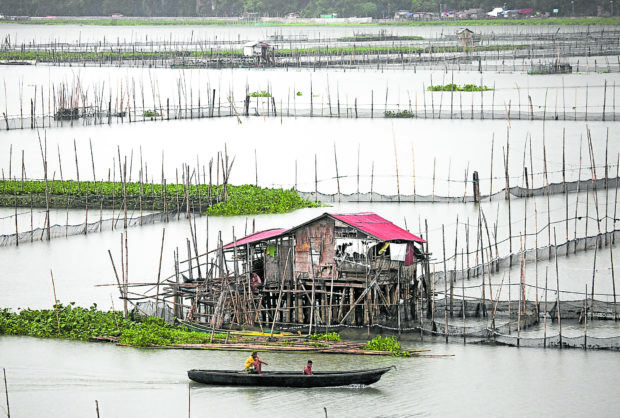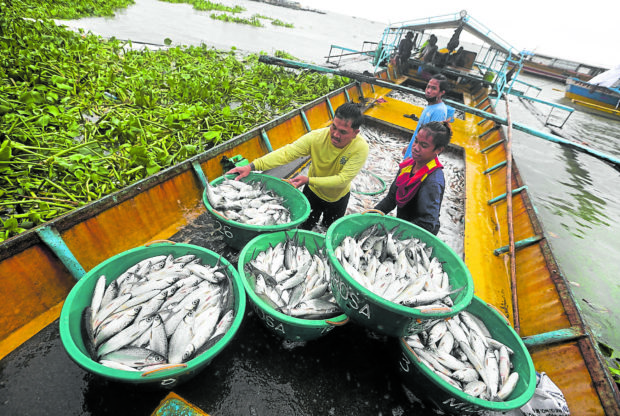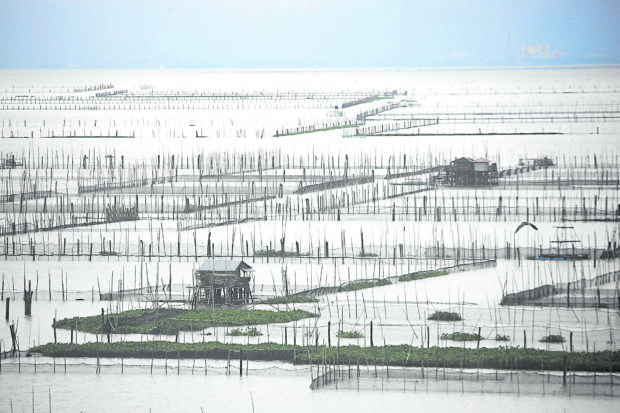Program for Laguna de Bay good, but fishers feel forgotten

FISHING GROUND Small fishermen share space with commercial fish pen operators in the Laguna de Bay, a 90,000-hectare lake spanning the provinces of Laguna and Rizal and parts of Metro Manila. In his first State of the Nation Address in 2016, President Duterte promised to help community-based fishermen, who depend on the lake for their livelihood, by giving them a bigger fishing
ground. —PHOTOS BY LYN RILLON
MANILA, Philippines — Jovito Mendoza, 64, has spent most of his life by the Laguna de Bay and his everyday hope is that some fish find its way into his “baklad” (trap).
At most, he harvests 5 kilos of “bangus” (milkfish), tilapia, or carp in a day and sells them in a wet market in Cardona town, Rizal province.
“Life was harder since the [COVID-19] pandemic [struck] because we could not move around [freely due to stay-at-home orders],” he said.
Mendoza, who relies on the excesses of the bigger fish pens in a multimillion-peso lake aquaculture, felt happy when President Duterte in 2016 included Laguna de Bay in his administration’s priorities.
In the president’s own words in his first State of the Nation Address, “the poor fishermen will have priority in its entitlements.”
Carrying capacity
The rehabilitation of the 90,000-hectare lake into a “vibrant economic zone that showcases ecotourism” tackled decades of watershed degradation, pollution, and land conversion.
Duterte blamed fish pen operators that outcompeted smaller fishermen, setting in motion a massive demolition of thousands of hectares of fishing structures during his first two years in office.
In 2018, the Laguna Lake Development Authority (LLDA) issued its Zoning and Management Guidelines (an update from 1999) that reduced from 15,000 ha to 9,200 ha the aquaculture area, based on the lake’s current carrying capacity.
It also implemented a 60 to 40 percent lake use sharing—5,520 ha for individual fishermen and fisherfolk cooperatives and 3,680 ha for corporations.

FRESH HARVEST “Batilyo,” or fish haulers, unload fresh small and medium-sized bangus at the Binangonan fish port in Rizal
province. Their boat carried 13 tons of milkfish harvested from a fish pen in Laguna de Bay.
Fishers’ cooperative
“But up to now, they still haven’t given us [a lake spot for a fish cage], although I heard some [fishers] got theirs in Taguig [City],” Mendoza said.
He added: “The President’s program is good, and there have been improvements, but I hope they do not forget about us.”
To ease the burden of government fees and operational costs, fisherfolk cooperatives were formed, each one entitled to a 5- to 20-ha cage.
A larger cage to grow in thousands of fingerlings means steadier income for Mendoza, who had the Sampad-Ticulio Fishermen Cooperative (named after two Cardona villages), registered with the Cooperative Development Authority in 2019. The community-based cooperative has 15 members.
Unhappy operators
In its five-year accomplishment report, the LLDA said 12,331 fishermen had registered with the agency as of December 2020.
The area occupied by aquaculture is down to 8,153.86 ha, of which about 4,000 ha went to cooperatives. From July 2016 to June 2021, the LLDA had freed up 5,415.89 ha from fishing structures.
The government charges a P4,000 per hectare annual fee for cages and P6,000 per hectare for fish pens (each about 25 to 50 ha).
Fish pen operators were unhappy, especially since their areas were reduced to give way to fisherfolk. Some cast doubt that cooperatives were being used as a front by the same businessmen and local politicians, who used to enjoy the rights over larger portions of the lake for years.
LLDA general manager Jaime Medina said the agency was aware of the “complaints” but assured that poor fishermen benefited, as regulated by the Fisheries and Aquatic Resource Management Councils.
“It’s a long process, but we have started. We got the ball rolling,” he said.
Aside from clearing fishing structures, Medina said lake rehabilitation requires major desilting, reforestation of tributaries and shoreland recovery.

FLAKE AQUACULTURE The aquaculture industry in the Laguna de Bay is among the major sources of freshwater fish in Metro Manila and nearby markets. “Bangus” (milkfish) and tilapia are grown in fish pens and other fishery structures, like these built in a section of the lake in Cardona, Rizal.
Multiuse potential
“I’m confident to say that [surrounding] industries are now more compliant [with environmental laws],” he said, following the agency’s issuance of 1,841 cease-and-desist orders for waste discharges and 101 orders against illegal shoreland occupants.
To enhance the lake’s multiuse potential, the government in 2020 piloted a solar energy project through floating panels in Laguna de Bay.
Also in the pipeline is the Laguna Lake Road Network for a highway link around the lake and a ferry system connecting it to the Pasig River.
Medina said the LLDA and the private Taguig Lake City Development Corp. in 2019 signed a memorandum for a P609-billion “Laguna Lake Lakebed Recovery and Rehabilitation Plan and Water Resource Development,” a major dredging project to increase the lake’s water-holding capacity.
Under the program, dredged materials will be used to recover and develop 8,888-ha of offshore land in the cities of Taguig and Muntinlupa.
The project has been endorsed to the National Economic and Development Authority for its approval early this year.